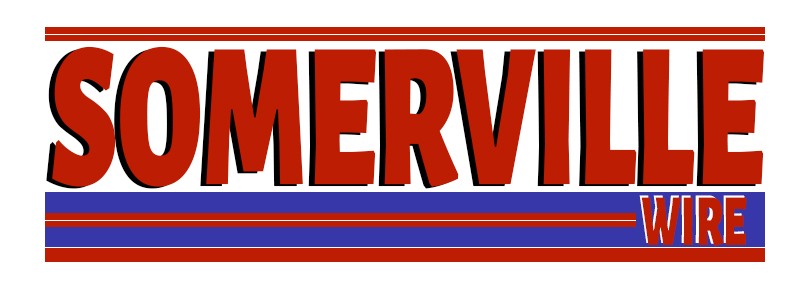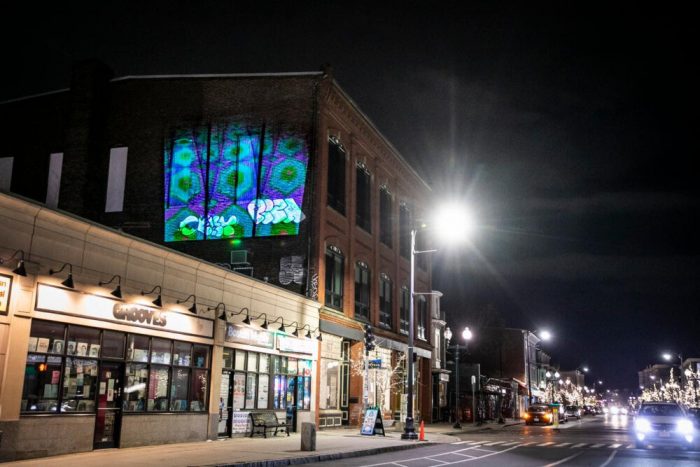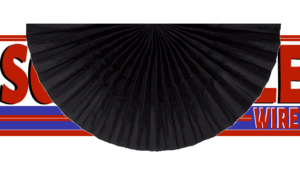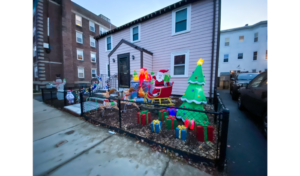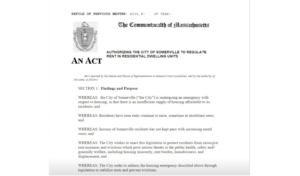Videos, street art, and public interventions assume vibrant, mind-bending dimensions in the hands of the digital artist and graphic designer
(Somerville Wire) – Allison Tanenhaus is a Boston-based, digital glitch artist. Through her work, she specializes in “bold geometrics, kaleidoscopic color fields, trippy op art, thought-provoking truisms, anachronistic tech mashups, and unexpected dimensional qualities.” Whether it’s creating guerilla installations, such as magnets and stickers, or developing public art, projected on a building wall in Union Square, her approach is always bold and unique. Her artwork will be featured at Somerville’s “Mistery Machine” on August 28. But here, Tanenhaus discusses her inspiration, sources—and why cats have found their way into her work.
Your artwork is abstract, psychedelic, and futuristic. What inspires your style, as an artist, and how would you describe your aesthetic as a creator? What do you want a viewer to take away from your artwork, or what kind of journey do you want them to take?
My aesthetic is a blend of unabashed (and often clashing) bright colors, dimension-bending perspectives, plus shapes and motions that just make your brain feel good.
For collage work (especially recent video work), I pull from past eras in both simulated ways (using filters, colors, and textures that evoke past decades) and in real ways, by appropriating public domain footage or vintage artifacts I’ve collected over the years (postcards, illustrations, playing cards). The result is a custom blend of saturated, anachronistic exuberance.
For pieces that look purely abstract, they’re often deep-down derived from something “real.” I’ll start with photos of my day-to-day life, then use phone apps to distort them into oblivion. Eventually, I daisy-chain enough apps in sequence—a visual game of telephone that I’m playing with myself—that what I create is far removed from its origins. But sometimes there are little traces, in subtle ways. Look closely in my busier abstractions and you may just spot something akin to a Hidden Pictures discovery! (It’s hard and not all that frequent, though. Don’t put much effort into this.)
Trying to define my art or explain it in a coherent way can be tricky…. I don’t feel like my art is meaningless, but to be honest, I don’t always know its meaning. At least not in a way that I can articulate.
As cryptic and sidesteppy as it may sound, I do believe that my art speaks for itself. As for what it’s saying? Can’t often say! But I get a gut feeling that each piece (that I show, at least) is coming out the way it’s supposed to. There’s some vibration that seems to emanate when colors, shapes, and unpredictable errors come together in certain ways.
I can’t define it in an academic way, but I know I’m onto something when it feels super satisfying. So everything I put out there goes through my internal quality control, and once it’s passed the test, everyone gets to enjoy it, too.
I hope you connect with my art in the same way I do: pulled into a meditative state of exploring a new landscape, and getting sucked in, like when you fell into a children’s book’s world when you were little. There’s this suspension, almost this transcendence that I want you to feel, to safely escape and take a mellow (or energizing) journey that rejuvenates you.
We spend so much time staring at screens and surfaces, and often what we see has the built-in motive (whether hidden or blatant) of wanting us to do, be, or buy something. Using my phone as a way to create something that doesn’t ask anything of you—except for you to enjoy yourself—feels weirdly, joyfully subversive.
Some of the work that you do is public art or street art. What is your creative process like when you are developing a piece, and what fuels your enthusiasm for art that is a part of public spaces? What do you see the role of guerrilla installations (magnets, banners, stickers) as being in the public realm?
I’m drawn to art that can serve a ton of people, whether in scale or availability, and affordably so. Transforming public places into destinations that prompt appreciation and reflection is the ultimate IRL installation! Anything’s better than a blank wall, and local art brings humanity and beauty anywhere, with no barriers to admission.
Meanwhile, my street art stickers are only a few bucks, so they’re a way for anyone to get their hands on my art, in a fun and collectible way—even if they’d never be able to travel to see my bigger public art in person.
Although I’m now doing lots more commercial commissions and public art projects (a.k.a. … receiving permission), guerrilla installations are where I started, and that DIY ethos of making things happen for their own sake still runs deep.
Part personal self-expression, part public service, guerrilla installations remove the gatekeeping (gallerists, collectors, and other established institutions) and permission-granting processes for traditionally showcasing art, which can often be prohibitive. Guerrilla installations reflect and fulfill the need to make your mark in locations where you find yourself.
What is your process like when making video art? What are your source materials, and how do you create glitch art that introduces errors into the electronic works you produce?
My approach with video art depends on the themes or intentions behind the particular project. But I typically start with public domain footage that matches the topic (if it’s a piece that has some “real” elements to it) or—if I’m going totally abstract—I’ll collect a bunch of images or videos I previously created that I haven’t quite figured out what to do with yet.
To back up a bit, I’m always making little clips as experiments, trying out different apps and techniques. There are tons of glitch art apps out there (which introduce errors and old school simulations, among other time- and space-defying effects), and then lots of image editing and animation apps. Many of these are made for enhancing photos proper, but you can really push them to rework abstract art, too.
I make little collections of images, sort of by default—I’m trying out variations in real time and saving as I go (since often I can’t replicate the exact parameters later), so I wind up with related families, though with unique attributes for each.
With video clips, I usually create three–15 second experiments (I get bored if I see the same thing for too long—I’m entertaining myself here, too!), and these can often be fresh angles on the same source material. These become my riffs or swatches. I know I’ll rework them and combine them in some fashion, but I don’t usually know what will happen to them during the creation stage. But if something looks good on its own, chances are it’s a good building block, too.
When I’m approaching a more intentional video piece—typically a music video—I’ll sift through my archive of material I haven’t used yet to see if I can either use it directly (or glitch it again and make something even newer and more mixed up!). I’ve ended up with a pretty robust library of bits and bobs that I can sample (and resample) later. Sometimes it’s easier to make something more custom (starting with images or colors that the collaborator or client requests), though. Often, it’s a mix of both.
Even with what look like dramatically different works at the surface—and even when my work can look very clearly digital—there’s always a throughline that I think shines through: my sheer delight in wielding color through whizzing, ecstatic compositions and op art configurations, seemingly emerging from several eras at once. All made with some wiggling of fingers (and smartphone apps made by smart people).
What has it been like to be an artist during the pandemic? Have you found yourself experimenting with different art forms or approaches, and has the pandemic influenced your work in any way?
I shifted my focus from interior design projects (like my work at Hotel Studio Allston) to more digital and virtual projects. I also became even more collaborative as a way to connect and stay grounded during the pandemic.
Of particular appeal, I linked up with musicians for album art, music videos, and visualizers. These partnerships turned me onto really cool new music, much of it local, and forged meaningful new bonds in my neighborhood.
On the flipside, I made friends literally all around the world (oh, technology!) through classes at the (online-for-now, but based in Berlin) School of Machines, Making, and Make-Believe. We worked on conceptual live art that could be performed via Zoom and other telematic applications. And I’m in a Mix of Media Affinity Group (virtual, for now) with the Cambridge Art Association, which has been a wonderful way to see what artists of vastly different mediums are up to and how we can support each other.
All of these pandemic experiences steered me towards more interdisciplinary explorations, often featuring styles, messages, and formats I hadn’t quite experienced before. So my process has involved more togetherness, while simultaneously embracing (or at least making the best of) distance.
Mistery Machine has been called the “chillest public art installation around.” What will the interactive art you are showcasing be like, and how is this a part of the Somerville Synth Crawl?
It will cool you off and it’s cool…so it’s chill in all respects!
Mistery Machine is a collaborative dream project that I concocted with my art-partner Ben K. Foley. (Together, we are bent/haus!) He’s another Somerville artist who’s a humble creative mastermind. He thinks in like…infinite dimensions. Case in point: The infinity mirror box he built for our group show “GlitchKraft” at Emerson Contemporary in fall 2019. He constructed the physical setup, then we projected my psychedelic video art into it, creating the illusion of infinite fields of kaleidoscopic motion.
For Mistery Machine, we took a similar approach. Ben has built a physical structure to which he attached misting heads (themselves attached to hoses) so we can create a blanket of cooling mist that’s in one semi-defined location. You’ll be able to walk under and inside it—perfect for cooling down on hot summer nights (especially given recent heat waves!).
The project has community heat resilience at its heart (we know that air conditioning can be prohibitive, much less safe shelter to begin with). Troublingly, the Northeastern US is warming faster than any other region in the lower 48. We’re grateful to Somerville’s Office of Sustainability & Environment for the Keep Cool Somerville Mini Grant that has enabled us to produce this accessible and timely experience for everyone.
The cooling mist could be a refreshing attraction in itself, but—adding that extra bent/haus flair—we’re also incorporating video art projections into it, as a life-sized mist-based light show.
And for one more layer on top of this eye-catching, cooling installation, we have two local and esteemed electronic music groups performing in sync with the video art: wunderkind Doug Bielmeier (Somerville), who will play his signature blend of lap steel and computer music, and The Square Root of Negative Two, which is synth legend Robin Amos (Somerville) and quirky, melodic genius Blaik Ripton (Malden) playing a mix of synthesizers, sequencers, and samplers (and even some drum tracks, recorded live on a little landing in our stairwell during a thunderstorm, when our upstairs and downstairs neighbors weren’t home; no noise complaints!), and me on visuals.
So it’s an ambient concert, a cooling mist that doubles as a public benefit, and a groovy video art exhibit all in one. To me, that safely qualifies as “chillest,” but you may want to experience it yourself, just to be sure.
As for the Somerville Synth Crawl, we discovered when planning that earlier in the day on Saturday, August 28 (when Mistery Machine is coming to Chuckie Harris Park in East Somerville), Modular on the Spot Boston (a group of folks who play modular synthesizer concerts in public parks—always free, always outdoors, and always modular; the Boston group is new and a spinoff from the original, which started in California) has a gig at the Somerville Community Growing Center.
It seemed wildly fantastic that two unconventional synth-based musical performances would be happening on the same day—in the same city! Richard Tarantino (the organizer of the MOTS event) and I quickly decided to team up and link the two events together to bolster the underground synth community and spread the word further afield about both free, outdoor, all ages, and extremely chill events in Somerville. 🙂
Finally, why cats?
I wasn’t into animals when I was little (mom was allergic), so I only started to spend quality time with them in my twenties. I developed deep bonds with a friend’s cat in college, then got my own cats and was like, “OK, I get it.”
Leaning into cats is such a wholesome interest; it’s refreshing, And it’s a lovely way to bond. When I meet other cat people, I’m genuinely excited to know about their cats (and maybe—one day—have a photoshoot!).
Kitties I’ve loved have become honorary mascots, emblazoned on various collectibles (stickers, keychains, prints, buttons, t-shirts). Cats + glitch art = my sweet spot when iit comes to aesthetics and subject matter: adorable groovy kitsch, accentuated by weirdo psychedelia. Exuberantly over the top, and lovingly so.
All Somerville Wire articles may be republished by community news outlets free of charge with permission and by larger commercial news outlets for a fee. Republication requests and all other inquiries should be directed to somervillewire@binjonline.org.
SUBSCRIBE TO THE FREE SOMERVILLE WIRE EMAIL NEWSLETTER: https://eepurl.com/hpBYPv
Shira Laucharoen is assistant director of the Boston Institute for Nonprofit Journalism and assistant editor and staff reporter of the Somerville Wire.
